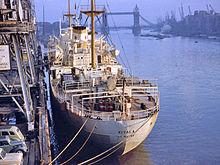- Pool of London
-
À l'origine, la Pool of London était la partie de la Tamise située au sud de la Cité de Londres. Le terme fut plus tard employé pour la partie du fleuve située entre le Pont de Londres et Rotherhithe (dans Southwark), qui constituait le point le plus extrême pour les grands bateaux à voiles. La Pool of London devint donc essentiel au port de Londres. Pour que son accès ne soit pas obstrué, un tunnel plutôt qu'un pont fut construit pour un nouveau raccordement piétonnier entre Rotherhithe et Wapping (dans Tower Hamlets).
 Un navire déchargeant en 1962
Un navire déchargeant en 1962
La Pool of London est divisée en deux parties, l' Upper Pool et la Lower Pool. L' Upper Pool comprend la section entre le Pont de Londres et le Tower Bridge, alors que la Lower Pool part traditionnellement de Tower Bridge au Cherry Garden Pier dans Rotherhithe.
La Pool of London fut vitale pour Londres pendant des siècles - dès le VIIe siècle Bède le Vénérable écrivait que la Pool était la raison de l'existence de Londres - mais elle atteint son apogée aux XVIIIe et XIXe siècles. À cette époque le fleuve était longé, presque en continu, d'un mur de quais s'étendant sur des kilomètres le long des deux rives, et des centaines de bateaux ancrés dans le fleuve ou amarrés le long des quais. La congestion était si extrême qu'il était dit qu'il était possible de traverser la Tamise en marchant simplement de navire à navire. Les Docklands ont leurs origines dans le manque de capacité de la Pool of London, qui incita des propriétaires fonciers à construire des docks fermés ayant une plus grande sécurité et un meilleur équipement que les quais de la Pool.
L'effondrement brusque du trafic commercial sur la Tamise due à l'introduction des conteneurs et des ports côtiers en eau profonde dans les années 60 vida la Pool et mena à la fermeture de tous les quais, beaucoup furent démolies. Le quartier a été intensivement reconstruit dans les années 80 et les années 90 pour créer de nouveaux ensembles résidentiels et commerciaux.
En 1996, une organisation - la Pool of London Partnership[1]- fut institutée pour aider à favoriser la rénovation urbaine des rives nord et sud du fleuve. Elle a également inclus dans son mandat les quais et les docks de St Katharine Docks et de Shad Thames. Après une décennie de régénération réussie et un investissement approximatif de 100 millions de Livres (125 millions d'Euros). La Pool of London Partnership fut dissoute en mars 2007, son programme est partiellement continué par trois nouveaux organismes : London Bridge Business Improvement District[2], Potters Fields Park Management Trust[3] et Tower Hill Management Group.
Le cœur du quartier inclut le Borough Market, le Pont de Londres, le Guy's Hospital, la gare de London Bridge, la Hay's Galleria, le HMS Belfast, l'Hôtel de ville de Londres, le Shad Thames, le Tower Bridge, le St Katharine Docks, la Tour de Londres, la station de métro de Tower Hill et le Monument au Grand incendie de Londres.
Références
Voir aussi
- Portail du monde maritime
- Portail de Londres
Catégories :- Port de commerce
- Port fluvial
- Port de la mer du Nord
- Économie de Londres
- Cité de Londres
- Tower Hamlets
- Southwark (district londonien)
- Géographie de Londres
Wikimedia Foundation. 2010.

